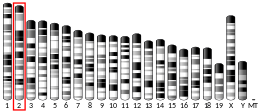PLCB2
Protein-coding gene in the species Homo sapiens From Wikipedia, the free encyclopedia
1-Phosphatidylinositol-4,5-bisphosphate phosphodiesterase beta-2 is an enzyme that in humans is encoded by the PLCB2 gene.[5][6][7]
Function
The gene codes for the enzyme phospholipase C β2. The enzyme catalyzes the formation of inositol 1,4,5-trisphosphate and diacylglycerol from phosphatidylinositol 4,5-bisphosphate. This reaction uses calcium as a cofactor and plays an important role in the intracellular transduction of many extracellular signals. This gene is activated by two G-protein alpha subunits, alpha-q and alpha-11, as well as G-beta gamma subunits.
Interactions
PLCB2 has been shown to interact with MAP2K3[8] and TRPM7.[9]
References
Further reading
Wikiwand - on
Seamless Wikipedia browsing. On steroids.






